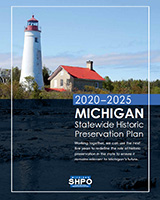Thousands of Resources, Ready to help.
Advantages
Popular

About SHPO
Connecting People and Places: Historic Preservation in Michigan
Detroit's East Ferry Avenue Historic District, the Hessel School House in Mackinac County, and the North Pier Lighthouse and Catwalk in Manistee. These historic properties, and thousands more, have been preserved and celebrated through the programs of Michigan's State Historic Preservation Office (SHPO).
Historic preservation enhances the quality of our environment and lives. Urban areas are renewed. Small towns retain and recognize the unique character that sets them apart from other communities. Neighborhoods are reclaimed from decline and are revived. Cultural landscapes are protected from uncontrolled development. Historic preservation is much more than an attempt to maintain old buildings for posterity's sake; it serves as a planning and economic development tool that enables communities to manage how they will grow and change. Once historic sites are identified and designated, protection programs and tax incentives can be used to preserve them. A commitment to the preservation of the character of our communities makes good economic sense because it enhances property values, creates jobs, revitalizes communities and promotes tourism.
In 1966, in response to growing public interest in historic preservation, Congress passed the National Historic Preservation Act (formally, the NHPA of 1996, amended 1980, 1992 [USC Sec. 470-470t]). The Act required that each state establish a State Historic Preservation Office (SHPO) and that the governor of each state appoint an Officer to oversee preservation activities. Michigan's SHPO was established in the late 1960s. Each year Michigan receives a Historic Preservation Fund grant from the National Park Service to operate its program, which must be matched by state dollars.
The Michigan SHPO's main function is to provide technical assistance to local communities and property owners in their efforts to identify, evaluate, designate, interpret and protect Michigan's historic above- and below-ground resources. The SHPO also administers incentive programs that include the Michigan Lighthouse Assistance Program, federal and state rehabilitation tax credits, and pass-through grants available to Certified Local Government communities. The SHPO must also develop a statewide historic preservation plan at regular intervals, informed by public input, to identify broad preservation priorities and goals. The knowledgeable and passionate SHPO staff is led by the state historic preservation officer, who is appointed by Michigan's governor to carry out provisions of the National Historic Preservation Act of 1966, as amended.
How broad are the Michigan SHPO's activities? We invite you to explore our recent statewide statistics. You can learn more specifics about what we do on the SHPO Programs and Services webpage.
Explore Michigan's 2020-2025 Statewide Historic Preservation Plan! The plan outlines broad preservation priorities and goals for this five year time period. The plan text was approved by the National Park Service in August, 2020. This plan is informed by public input and stakeholder feedback obtained throughout 2019 at regional workshops across the state.
The creation of a five-year statewide historic preservation plan is a federal requirement for each state's historic preservation office. The staff of the SHPO is constantly assessing the opportunities and threats facing historic preservation in Michigan and looking for ways to address them.

Michigan Statewide Historic Preservation Plan, 2020-2025
Explore the PlanThe SHPO programs are funded, in part, with federal funds from the National Park Service, U.S. Department of the Interior. However, the contents and opinions herein do not necessarily reflect the views or policies of the Department of the Interior, nor does the mention of trade names or commercial products constitute endorsement or recommendation by the Department of the Interior. Under Title VI of the Civil Rights Act of 1964, Section 504 of the Rehabilitation Act of 1973, and the Age Discrimination Act of 1975, as amended, the U.S. Department of the Interior prohibits discrimination on the basis of race, color national origin, or disability or age in its federally assisted programs. If you believe you have been discriminated against in any program, activity, or facility as described above, or if you desire further information, please write to: Office for Equal Opportunity, National Park Service, 1849 C Street, N.W., Washington, DC 20240.